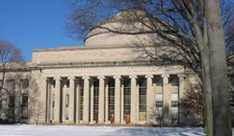
Development of a Coal-CO2 Slurry Feeding System for Pressurized Entrained-Flow Gasifiers in Plants with Carbon Captures
Electrochemically- Mediated Amine Regeneration for Post-Combustion Capture of Carbon Dioxide
Project: Electrochemically-Mediated Amine Regeneration for Post-Combustion Capture of Carbon Dioxide
Research Team: Michael Stern, Fritz Simeon, Howard Herzog and T. Alan Hatton
Sponsor: Advanced Research Project Agency-Energy (ARPA-e) & Siemens AG
Year: 2013
Abstract:
Post-combustion carbon capture and storage is a necessary technology for reducing greenhouse gas emissions, while maintaining the current availability of cheap electricity. In addition to equipping new fossil fuel power plants with carbon capture facilities, existing plants must be retrofitted with capture technology or replaced in order to significantly reduce carbon emissions. Current state-of-the-art amine scrubbing technology, however, is poorly suited for retrofits of existing plants because it would require costly reconfiguration of the steam turbines. Even with the reconfiguration, the parasitic energy losses would be high, as compared to a new plant, due to the difficulties of retrofitting plants with thermal-swing amine scrubbers.
Electrochemically-Mediated Amine Regeneration (EMAR) offers many of the advantages of thermal-swing amine scrubbing in a format that is more conducive to retrofits of existing plants. Rather than relying on steam from between the intermediate- and low-pressure turbines to power a thermal swing cycle, the EMAR system simply diverts a fraction of the electricity being generated by the plant to run the capture process. This avoids both the costly turbine reconfiguration and the high parasitic energy requirements of the thermal scrubbing system. This technology also allows for flexible operation, where electricity could be quickly redirected to the grid during times of unusually high energy demand. EMAR can also release the carbon dioxide at high pressures, reducing 50% of downstream compression requirements for sequestration.
EMAR uses a newly developed electrochemical regeneration cycle based on the coordination chemistry between copper ions and amine sorbent molecules. Through application of a positive potential to a copper anode, copper ions can be generated to displace the carbon dioxide from the binding sites of the amine sorbents, which facilitates the release of the carbon dioxide in the gas phase. Application of the opposite potential to a downstream copper cathode facilitates the uptake of the copper ions onto the electrode, thereby regenerating the sorbent solution.
Publications:
Stern, M., "Electrochemically-Mediated Amine Regeneration for Carbon Dioxide Separations," M.I.T. Ph.D. Dissertation, (2013). <PDF>
Stern, M. C., F. Simeon, H.J. Herzog, T. A. Hatton, "An Electrochemically-mediated Gas Separation Process for Carbon Abatement," Energy Procedia, Vol 37, pp 1172-1179, Aug (2013). <PDF>
Stern, M.C., F. Simeon, H.J. Herzog, T. A. Hatton, "Post-Combustion Carbon Dioxide Capture using Electrochemically-Mediated Amine Regeneration", Energy & Environmental Science, vol 6(8), pp 2505 - 2517, June (2013). Note: Subscription may be required to view article <Link to online article> <MIT Technology Review> <MIT News Office>
Stern, M. C., Electrochemically-mediated Amine Regeneration for CO2 Separations, presented at the ACS Spring Meeting: Energy and Fuels Division, New Orleans, LA, April (2013).
Stern, M. C., F. Simeon, T. Hammer, H. Landes, H.J. Herzog, T.A. Hatton, Electrochemically Mediated Separation for Carbon Capture, Energy Procedia, Vol 4, pp 860-867, Feb (2011). <PDF>
Patent Applications:
Stern, M. C., F. Simeon, T.A. Hatton, Methods and Systems for Carrying out a pH Influenced Chemical or Biological Reaction, US Patent Application No 20130058857, Published (2013).